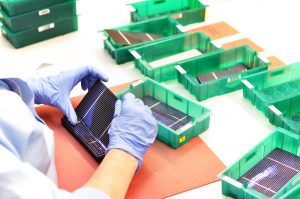This application of anti-reflection (AR) coatings to lenses can improve the efficiency of the optics through increasing its transmission, enhancing contrast and eliminating any “ghost” images that may appear.
The application of an AR coating will make the lens more durable and allow it withstand environmental and physical damage. This is a plus when the lenses are used in industrial or manufacturing settings. Transmissive options typically utilize AR coatings because of the environment in which they operate.
Individuals requiring anti-reflection coatings need to know the range of the system into which the lenses will be utilized in order to determine the correct type of coating. AR coating can enhance the overall performance of an optical system, however the correct type coating must be applied. For example, an AR coating that is outside of the wavelength range of the design could lead to a potential decrease in the overall performance.

Solar Cell Inspection
What does AR coating do?
When an anti-reflective coating is applied it cuts down on the light that passes through the glass. Without AR, light will pass through the uncoated piece of glass and about 5 percent of it will be reflected, this means that there is a total transmission of only 95 percent of the “inciting light.” When the AR coating is applied, it will increase the throughput of light through the system and will reduce any potential hazards of the light traveling back into the system; this is what causes ghost images. The application of an anti-reflective coating is critical to obtaining correct results and readings if the technology is utilizing multiple optical transmitting elements.
The thickness of the coating applied will determine the both the angle and the incident of light that passes through the lens.
¼ λ MgF2: The simplest AR coating used is ¼ λ MgF2 centered at 550nm (with an index of refraction of 1.38 at 550nm). MgF2 coating is ideal for broadband use though it gives varied results depending upon the glass type involved.
VIS 0° and VIS 45°: VIS 0° (for 0° angle of incidence) and VIS 45° (for 45° angle of incidence) provide optimized transmission for 425 – 675nm, reducing average reflection to 0.4% and 0.75% respectively. VIS 0° AR coating is preferred over MgF2 for visible applications.
VIS-NIR: Our visible/near-infrared broadband anti-reflection coating is specially optimized to yield maximum transmission (>99%) in the near infrared.
Telecom-NIR: Our telecom/near-infrared is a specialized broadband AR coatings for popular telecommunications wavelengths from 1200 – 1600nm.
UV-AR and UV-VIS: Ultraviolet coatings are applied to our UV fused silica lenses and UV fused silica windows to increase their coating performance in the ultraviolet region.
NIR I and NIR II: Our near-infrared I and near-infrared II broadband AR coatings offer exceptional performance in near-infrared wavelengths of common fiber optics, laser diode modules and LED lights.
SWIR: Our Short-Wave Infrared (SWIR) broadband anti-reflection coating is designed for maximum transmission of wavelengths from 900 – 1700nm for common SWIR applications including electronics or solar cell inspection, surveillance, or anti-counterfeiting.